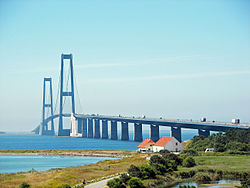Great Belt Bridge (East Bridge) | |
|---|---|
 The East Bridge as seen from the Sjælland side | |
| Coordinates | 55°20′31″N 11°02′10″E / 55.34194°N 11.03611°E |
| Carries | 4 lanes of E20 |
| Crosses | Great Belt |
| Official name | Østbroen |
| Maintained by | A/S Storebælt |
| Characteristics | |
| Design | Suspension bridge |
| Material | Concrete and steel |
| Total length | 6,790 metres (22,277 ft) |
| Width | 31 metres (102 ft) |
| Height | 254 metres (833 ft) |
| Longest span | 1,624 metres (5,328 ft) |
| Piers in water | 19 |
| Clearance below | 65 metres (213 ft) |
| History | |
| Designer | COWI, Ramboll & Dissing+Weitling |
| Constructed by | Hochtief, Skanska, Højgaard & Schultz and Monberg & Thorsen |
| Construction start | 1991 |
| Construction end | 1998 |
| Opened | 14 June 1998 |
| Statistics | |
| Toll | 275 DKK (€37/$40) per car.[1] |
| Location | |
 | |
The Great Belt Bridge (Danish: Storebæltsbroen) or Great Belt fixed link (Danish: Storebæltsforbindelsen) is a multi-element fixed link crossing the Great Belt strait between the Danish islands of Zealand and Funen. It consists of a road suspension bridge and a railway tunnel between Zealand and the small island Sprogø in the middle of the Great Belt, and a box-girder bridge for both road and rail traffic between Sprogø and Funen. The total length is 18 kilometres (11 mi).[2]
The term Great Belt Bridge commonly refers to the suspension bridge, although it may also be used to mean the box-girder bridge or the link in its entirety. Officially named the East Bridge, the suspension bridge was designed by the Danish firms COWI and Ramboll, and the architecture firm Dissing+Weitling. It has the world's sixth-longest main span (1.6 km (1 mi)). At the time of the opening of the bridge it was the second longest, beaten by the Akashi Kaikyō Bridge opened a few months previously.
Together with the New Little Belt Bridge, the Great Belt link provides a continuous road and rail connection between Copenhagen and the Danish mainland. The link replaced the Great Belt ferries service, which had been the primary means of crossing the Great Belt. After more than 50 years of debate, the Danish government decided in 1986 to construct a link;[3] it opened to rail traffic in 1997 and to road traffic in 1998. At an estimated cost of DKK 21.4 billion (EUR 2.8 billion) (1988 prices),[2] the link is the largest construction project in Danish history.[4] It has reduced travel times significantly; previously taking one hour by ferry, the Great Belt can now be crossed in ten minutes. This link, together with the Øresund Bridge (built 1995–1999) and the Little Belt Bridge, have together enabled driving from mainland Europe to Sweden through Denmark.
Operation and maintenance are performed by A/S Storebælt under Sund & Bælt. Construction and maintenance are financed by tolls on vehicles and trains. Cyclists are not permitted to use the bridge, but bicycles may be transported by train or bus.
- ^ Storebælt.dk (2024). "Prices". A/S Storebælt. Retrieved 21 January 2024.
- ^ a b Cite error: The named reference
faktawas invoked but never defined (see the help page). - ^ DSB: Passagerens håndbog (in Danish). DSB. 1990. p. 73. ISBN 87-7025-152-5.
- ^ "The Bridge". A/S Storebælt. Archived from the original on 23 June 2013. Retrieved 4 December 2008.